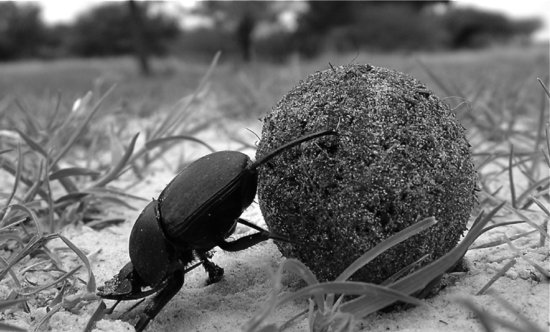10.2 Experiment 1: Visual Orientation in a Beetle
Scarabaeus zambesianus, an African dung beetle, flies off at sunset to forage for fresh dung. Once it finds some, it quickly forms a ball of dung with its front legs and head and rolls it away in a straight line – the most efficient path for escaping aggressive competitors for food in the dung pile. Apart from its peculiar eating habits, it also has an interesting ability to orient itself using the pattern of polarized light that forms in the sky at sunset. As shown in Figure 10.2, a dung beetle pushes the balls backwards with its hind legs. Despite being unable to see in the direction that it is moving, it maintains its departure bearing over a long distance. The beetle does this by using specialized photoreceptors in its compound eyes that sense the direction of polarization in the sky.
Figure 10.2 Dung beetle pushing a ball away from the dung pile using its hind legs. © Marie Dacke.

The reason that the sky has a polarization pattern is that sunlight is scattered off molecules in the air. This process is known as Rayleigh scattering and is also the reason why the daytime sky is not pitch black but has a soft blue glow. For the reasons explained in Box 10.1, the degree of polarization varies across the sky in relation to the direction of the sun. A band of highly polarized light stretches across the zenith at sunset, with the ...
Get Experiment!: Planning, Implementing and Interpreting now with the O’Reilly learning platform.
O’Reilly members experience books, live events, courses curated by job role, and more from O’Reilly and nearly 200 top publishers.

